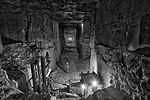Portland Windmills
Grade II listed buildings in DorsetGrade II listed windmillsIsle of PortlandTower mills in the United KingdomUse British English from November 2013 ... and 1 more
Windmills in Dorset

The Portland Windmills are two disused stone towers which were used as windmills from at least the early 17th century. They are located south of Easton village and the east of Weston village. The towers, which are relatively short mills with conical caps, stand approximately 135 metres apart. They have been separate Grade II Listed monuments since September 1978, and are the only historic windmill remains to survive in Dorset.
Excerpt from the Wikipedia article Portland Windmills (License: CC BY-SA 3.0, Authors, Images).Portland Windmills
Clarence Road,
Geographical coordinates (GPS) Address Phone number Website Nearby Places Show on map
Geographical coordinates (GPS)
| Latitude | Longitude |
|---|---|
| N 50.541 ° | E -2.437 ° |
Address
St George's Primary School (St George's Community Primary School)
Clarence Road
DT5 2BD , Portland
England, United Kingdom
Open on Google Maps











